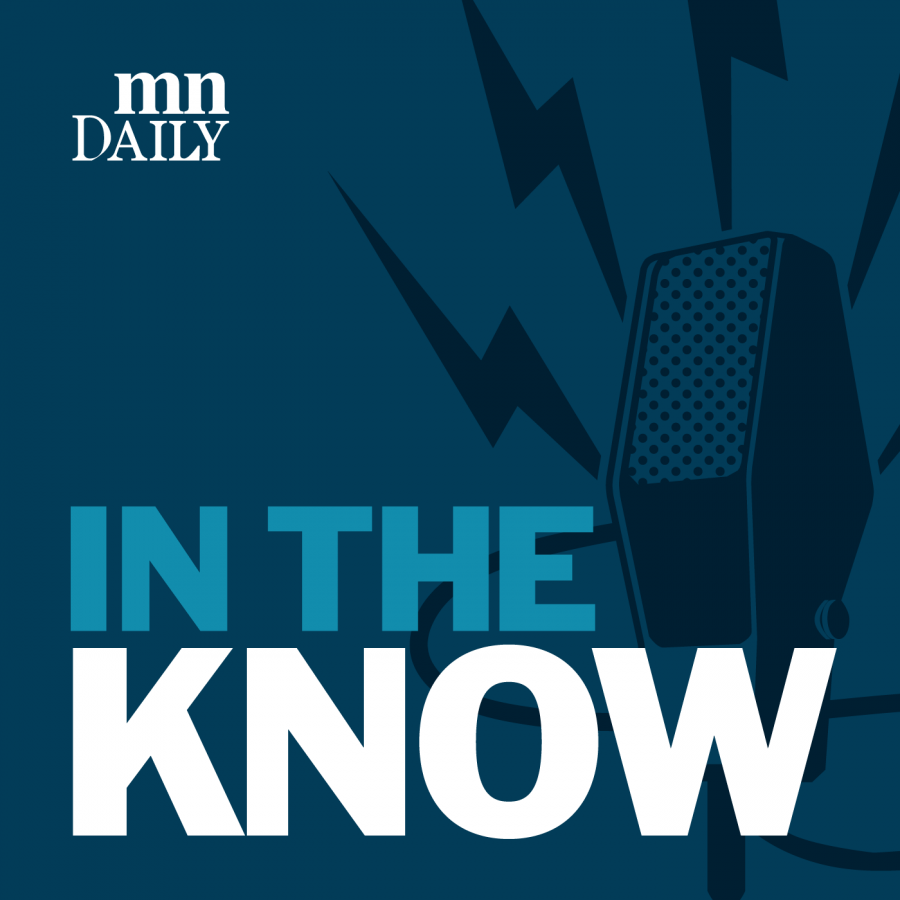MAYA ATHERLY-LARSEN: Hi, I’m Maya Atherly-Larsen. You’re listening to In The Know, a podcast dedicated to the University of Minnesota.
Welcome to the frosty wonderland of Minnesota winters, where the chill seeps into your bones and the sun seems to be on an extended vacation. The winter months in Minnesota are easily the gloomiest times of the year.
But hey, let’s talk about something that’s not just snow and ice, but a little more serious like seasonal affective disorder, also known as SAD. It’s like the winter blues dialed up to 11, making everything from finishing your homework to hanging out with friends feel like climbing Mount Everest. In this episode, we’re cracking open the all too common SAD phenomenon, especially how it affects students and how you can keep the winter blues at a minimum! So, what is seasonal affective disorder? Assistant psychology professor Dr. Liza Meredith explains that as the name suggests, it pops up as the seasons change.
LIZA MEREDITH: Seasonal depression is a mood disorder that comes on during certain times of the year. During certain times of the year, people usually feel a lower mood than what is typical for them, and it’s often in the wintertime when people aren’t getting their normal levels of sunlight and physical activity.
ATHERLY-LARSEN: Think of it this way: imagine a plant deprived of sunlight and water. Sooner or later, it’s going to wilt and struggle. Seasonal affective disorder is a bit like that wilted plant, but for people. Although SAD is common here in Minnesota, Cecilia Bloomquist, psychotherapist and Associate Director of Mental Health Services at Boynton Health, explains how this condition is completely regional.
CECILIA BLOOMQUIST: I’m from Brazil. So when I came to the U. S. for the first time, I started hearing about it and I’m like, what is, why people are so concerned about this here, right? I didn’t hear much about in Brazil it’s because you don’t see that many cases down there.
The seasonal affective disorder is it seems to be a stronger correlation with the weather change. So when we have the shorter days, so sunlight makes a difference, right? You have, like, a lot of sunlight or short of sunlight. It seems like that can affect the symptoms associated with that.
ATHERLY-LARSEN: Navigating the winter months in Minnesota can be quite the challenge for those dealing with the disorder, particularly for students like Lukas Rowley, a freshman at UMN.
LUKAS ROWLEY: So getting to college I really struggled with the sleep schedule, just medically some stuff was going on there. And so I would wake up generally, uh, I had some days where I’d wake up 5 p.m. and so I didn’t get a lot of sunlight, didn’t get a lot of vitamin D.
And so, pretty early on in the semester, I definitely felt like I was just, I mean, that, like, that lack of hope, that lack of motivation, you know, having difficulties getting up out of bed every day, I think, I think, um, that lack of drive is so, like, I mean, once you’re not motivated to fix the issues that you face, it’s like, that’s kind of, there’s not much you can do.
DREW BROMLEY: Being a student there’s something about not being outside as much. I find that especially when there’s not a ton of sunlight and you’re like grinding through whether that be finals or the beginning of a new semester the burden can get kind of heavy.
And then socially there’s just less going on. Everything’s got to be inside. Now, there are plenty of things to do and I found it’s pretty easy to get outside, but I think on the large scale, I mean, you’re just not, there’s not as much stuff going on outside. It’s a little harder. You really got to plan to do stuff. It’s not just like, Oh, go outside, see what happens. You got to plan to do stuff.
ATHERLY-LARSEN: UMN sophomore Drew Bromley explains how the cold weather can put a serious damper on students’ social lives. With fewer opportunities for social interaction, coupled with a general lack of motivation, completing assignments and staying on top of responsibilities become incredibly challenging for students. Bromley also delves into his own academic struggles amidst these conditions.
BROMLEY: It’s needed a lot more effort like it’s been a little bit more laborious if you will, when the winter comes around that you really kind of do have to like apply yourself, which is a good skill to have, but it’s just that little extra because, like, in the beginning of the year, you got a lot to look forward to. And, like, when the weather’s nice, it’s pretty easy to get yourself to do something sometimes, like, all right, whatever. I’ll just go do this. We’re in the winter. It’s like, there’s not much else going on. It can be a little harder to get yourself going.
MEREDITH: Mood disorders in general, including seasonal affective disorder can affect all different areas of life, including academic performance, work relationships. So with a mood disorder, a lot of times people are experiencing low mood, they’ll feel a sense of apathy. They’ll feel a sense of sadness, feeling a sense of isolation or disconnection, and that can make it hard to feel motivated to do things like go to class or, you know, leave your living space to go study somewhere that might be more helpful for you for getting things done.
So, overall like, people often feel kind of apathetic, unconcerned and maybe unmotivated to do things they would normally do, which can make school performance harder. Same, like, from a social perspective, people might not feel as motivated to see other people even though they know maybe they should see other people they know intellectually, it will help. They don’t feel like they have the motivation or energy to like get out and see other people or do things.
ATHERLY-LARSEN: Seasonal affective disorder has always been an issue, but after the Covid-19 pandemic, many witnessed symptoms getting worse.
BLOOMQUIST: It’s getting more extended. It’s just like symptoms appreciably more severe than usual since since the pandemic, it’s it has been a lot harder on mental health and I think it’s a worldwide issue that is affecting our system. It’s overloading a lot of places. Because of that, something that, we actually really, I’m really grateful that here we have pretty good access at this point if we compare to the community it’s pretty good now. People can get in and get good help.
ATHERLY-LARSEN: Dealing with this disorder can be very taxing, but there are some coping skills and healthy habits you can implement into your day. Establishing a consistent bedtime routine and spending time in sunlight are beneficial practices, but among them, exercise and maintaining social connections appear to be particularly effective. Bloomquist recommends utilizing the University Rec center as a resource to support these efforts.
BLOOMQUIST: The RecWell has now a nice track there, indoor track. If you’re not, if it’s too cold, you can still walk there and then they have those huge windows. There’s some sunlight coming around. Find things that are enjoyable during the winter months. Now, if you know, if you are the person that like me that loves winter sports and it’s like that, if you get to now go skiing, go ice skating, you don’t need to be good at it, it’s just like the, now it’s the fun, it’s the opportunity to get outside.
ATHERLY-LARSEN: Based on his experiences, Bromley recommends finding a community to stay involved.
BROMLEY: It’s spending time with people. I think being in community is super vital, especially in the winter when you’re kind of when you can feel a little isolated when it’s cold out. You don’t want to go out.
For me, like just being with my friends, we do a lot of movie marathons in the winter. Harry Potter’s a classic winter binge thing. I love my church community. I go to Salt Company here at the U and I’ve found in the winter, like I really need that even more so. Just like a place to be with people in a warm building, just to have those opportunities.
ATHERLY-LARSEN: There are many coping skills you can try out to see what works best for you, but at the end of the day it’s all about what makes you happy and keeps you going. Bloomquist encourages prioritizing activities, no matter how small, that spark joy in your life.
BLOOMQUIST: Maybe there’s some craft projects that you like to do that is associated with winter or gatherings that you can do, books or, you know, or projects at home, but it brings you joy. It keeps you moving.
ATHERLY-LARSEN: And if all else fails, find a support system and seek out professional help.
BLOOMQUIST: A good option is to, you can talk with your primary care physician. Now you can come to Boynton. Talk with, now, with primary care. You can schedule an appointment for therapy and talk with someone. Now we’ll recommend any further treatment.
ATHERLY-LARSEN: If students have concerns about wait times, Boynton and Student Counseling Services reassure them of their dedication to connecting students with the necessary mental health support. Typically, students can expect initial consultations for therapy within one to two weeks of requesting services, a significantly faster timeframe compared to many community providers.
For immediate assistance, same-day and drop-in support are available on weekdays through urgent crisis counseling and Let’s Talk. Additionally, the UMN student crisis line operates 24/7; students can call 612-301-4673 or text “UMN” to 61222.
While talk therapy remains a valuable option, Meredith underscores the importance of exploring alternatives, as there is no one-size-fits-all approach to mental health care.
MEREDITH: So, I think there are many things that can help seasonal depression. The exact thing that would work best probably depends on the person, but people do benefit from things like medications, um, seeing a therapist or doing something like light based therapy, where you get something called a happy light that can be helpful for getting more light exposure outside of these, like more medical focus treatments, right?
There’s also maybe informal things that can help you. Sometimes, like, having an accountability buddy can be helpful. Someone that kind of knows that you’re struggling with something like that and encourages you to get out even when you don’t want to.
ATHERLY-LARSEN: Facing seasonal affective disorder can make any time of year feel like a struggle. If you’re grappling with it, don’t hesitate to lean on your support system—friends and family are there to lift you up. Seeking professional help is always an option, too. Just remember, your happiness and health are always a top priority, regardless of the season.
This episode was written by Maya Atherly-Larsen and produced by Kaylie Sirovy. As always, we appreciate you listening in and feel free to leave us an email at [email protected] with questions or concerns. I’m Maya, and this is In The Know.













Wendy Eilers
Feb 1, 2024 at 4:40 pm
Very informative for everyone. Seek help if you need it. I like the buddy system. Someone looking out for you who is there to help you.